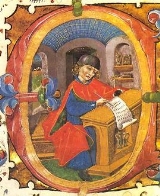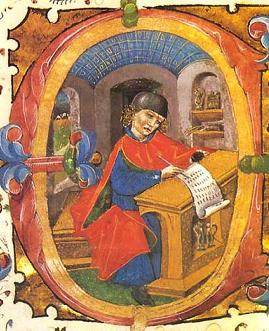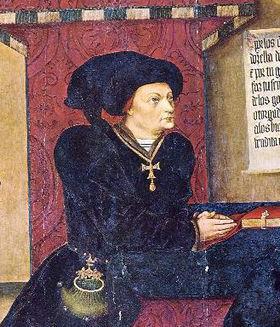
Íñigo López de Mendoza, marqués de Santillana
Encyclopedia


Don (honorific)
Don, from Latin dominus, is an honorific in Spanish , Portuguese , and Italian . The female equivalent is Doña , Dona , and Donna , abbreviated "Dª" or simply "D."-Usage:...
Íñigo López de Mendoza y de la Vega, Marquis of Santillana (August 19, 1398 – March 25, 1458) was a Castilian
Castile (historical region)
A former kingdom, Castile gradually merged with its neighbours to become the Crown of Castile and later the Kingdom of Spain when united with the Crown of Aragon and the Kingdom of Navarre...
politician and poet
Poet
A poet is a person who writes poetry. A poet's work can be literal, meaning that his work is derived from a specific event, or metaphorical, meaning that his work can take on many meanings and forms. Poets have existed since antiquity, in nearly all languages, and have produced works that vary...
who held an important position in society and Literature
Literature
Literature is the art of written works, and is not bound to published sources...
during the reign of John II of Castile
John II of Castile
John II was King of Castile from 1406 to 1454.He was the son of Henry III of Castile and his wife Catherine of Lancaster, daughter of John of Gaunt, 1st Duke of Lancaster by Constance of Castile, daughter of King Peter of Castile.-Regency:He succeeded his father on 25 December 1406, at the age of...
.
He was born at Carrión de los Condes
Carrión de los Condes
Carrión de los Condes is a municipality in the province of Palencia, part of the Autonomous Community of Castile and León, Spain.It is 40 kilometers from Palencia, on the Way of Saint James.-History:...
in Old Castile to a noble family which figured prominently in the arts. His grandfather, Pedro González de Mendoza, and his father, Diego Hurtado de Mendoza
Diego Hurtado de Mendoza (Admiral of Castile)
Diego Hurtado de Mendoza was the Admiral of Castile and tenth head of the House of Mendoza. He was the son of Pedro González de Mendoza and Aldonza López de Ayala.-Biography:Diego was born in the city of Guadalajara...
Admiral of Castile
Admiral of Castile
Admiral of Castile was a post with a long and important history in Spain. One famous holder was Fadrique Enríquez.Another was Admiral Don Bernardo de Sarrià, Baron of Polop and nobleman in the service of King James II of Aragon....
, were both poets with close ties to the great literary figures of the time: Chancellor Lopez de Ayala, Fernán Pérez de Guzmán
Fernán Pérez de Guzmán
Fernan Perez de Guzman was a Spanish historian and poet. He belonged to a family distinguished both for its patrician standing and its literary connections, for his uncle was Pero López de Ayala, Grand Chancellor of Castile, historian and poet, and his nephew was the Marquis of Santillana, one of...
and Gomez Manrique
Gómez Manrique
Gómez Manrique , Gómez Manrique y de Castilla was a Spanish poet, soldier, politician and dramatist born in Amusco. The fifth son of Pedro Manrique de Lara y Mendoza, , adelantado mayor of Leon...
.
His mother, Doña Leonor de la Vega, was a wealthy heiress belonging to the House of de la Vega.
Lopez de Mendoza's father died when he was five years old, which brought his family into financial difficulties. Part of his childhood was spent living in his grandmother's household, and in the home of his uncle, the future Archbishop of Toledo. As a youth, he spent time in the court king Alfonso V of Aragón
Alfonso V of Aragon
Alfonso the Magnanimous KG was the King of Aragon , Valencia , Majorca, Sardinia and Corsica , and Sicily and Count of Barcelona from 1416 and King of Naples from 1442 until his death...
, where he was exposed to the work of poets in the Provençal, Valencia and Catalan traditions, the classic Humanist works of Virgil
Virgil
Publius Vergilius Maro, usually called Virgil or Vergil in English , was an ancient Roman poet of the Augustan period. He is known for three major works of Latin literature, the Eclogues , the Georgics, and the epic Aeneid...
and Dante Alighieri
Dante Alighieri
Durante degli Alighieri, mononymously referred to as Dante , was an Italian poet, prose writer, literary theorist, moral philosopher, and political thinker. He is best known for the monumental epic poem La commedia, later named La divina commedia ...
, and the lyricism of troubadours such as Enrique de Villena
Enrique de Villena
Enrique de Aragón , Marquess of Villena, was a medieval Spanish writer, theologian and poet. He was also the last legitimate descendant of the royal house of Aragón and the counts of Barcelona. When political power was denied to him, he turned to writing and was reputed to be a great...
.
In 1412, Don Íñigo married a wealthy heiress, Catarina Suárez de Figueroa. With this union, he acquired great fortune and became one of the most powerful nobles of his time. His sixth son from the marriage would one day become Cardenal Mendoza
Pedro González de Mendoza
Pedro González de Mendoza was a Spanish cardinal and statesman.-Biography:He was born at Guadalajara in New Castile, the chief lordship of his family. He was the fourth son of Íñigo López de Mendoza, marqués de Santillana, deceased 1458, and one of the cadet brothers of Diego Hurtado de Mendoza, 1...
.
As a politician, Don Íñigo remained loyal to Juan II throughout his life, for which he was richly rewarded with land and the title of Marquis of Santillana in 1445, after the First Battle of Olmedo. When his wife Doña Catarina de Figueroa died, the Marquis retired to his palace of Guadalajara
Guadalajara, Spain
Guadalajara is a city and municipality in the autonomous community of Castile-La Mancha, Spain, and in the natural region of La Alcarria. It is the capital of the province of Guadalajara. It is located roughly 60 km northeast of Madrid on the Henares River, and has a population of 83,789...
to spend the rest of his life in peaceful study and contemplation.
Lopez de Mendoza was a great admirer of Dante Alighieri
Dante Alighieri
Durante degli Alighieri, mononymously referred to as Dante , was an Italian poet, prose writer, literary theorist, moral philosopher, and political thinker. He is best known for the monumental epic poem La commedia, later named La divina commedia ...
and his work is categorized within the allegorical-Dantesque School. He also assimilated Petrarch
Petrarch
Francesco Petrarca , known in English as Petrarch, was an Italian scholar, poet and one of the earliest humanists. Petrarch is often called the "Father of Humanism"...
and Giovanni Boccaccio
Giovanni Boccaccio
Giovanni Boccaccio was an Italian author and poet, a friend, student, and correspondent of Petrarch, an important Renaissance humanist and the author of a number of notable works including the Decameron, On Famous Women, and his poetry in the Italian vernacular...
's Humanism
Humanism
Humanism is an approach in study, philosophy, world view or practice that focuses on human values and concerns. In philosophy and social science, humanism is a perspective which affirms some notion of human nature, and is contrasted with anti-humanism....
.
He is especially remembered for his "serranillas", which are small poems that focus on commonplace subjects. He also wrote pastoral
Pastoral
The adjective pastoral refers to the lifestyle of pastoralists, such as shepherds herding livestock around open areas of land according to seasons and the changing availability of water and pasturage. It also refers to a genre in literature, art or music that depicts such shepherd life in an...
novels inspired by French tradition, and was originator of the Castilian Sonnet.
Children
- Diego Hurtado de Mendoza, 1st Duke of the Infantado.
- Pedro Lasso de Mendoza, señor del valle del Lozoya.
- Íñigo López de Mendoza, 1st count of TendillaÍñigo López de Mendoza, 1st count of TendillaÍñigo López de Mendoza, 1st count of Tendilla, was the second son of famous Spanish Poet and nobleman Íñigo López de Mendoza y Lasso de la Vega, marquis of Santillana, , and the cadet brother of Diego Hurtado de Mendoza, 1...
- Mencía de Mendoza, married Pedro Fernández de Velasco, 2nd Count of Haro.
- Lorenzo Suárez de Mendoza y Figueroa, Conde de la Coruña.
- Pedro González de MendozaPedro González de MendozaPedro González de Mendoza was a Spanish cardinal and statesman.-Biography:He was born at Guadalajara in New Castile, the chief lordship of his family. He was the fourth son of Íñigo López de Mendoza, marqués de Santillana, deceased 1458, and one of the cadet brothers of Diego Hurtado de Mendoza, 1...
, cardinal and confidant of Queen Isabella I of CastileIsabella I of CastileIsabella I was Queen of Castile and León. She and her husband Ferdinand II of Aragon brought stability to both kingdoms that became the basis for the unification of Spain. Later the two laid the foundations for the political unification of Spain under their grandson, Charles V, Holy Roman Emperor...
. - Juan Hurtado de Mendoza, señor de Colmenar, El Cardoso y El Vado.
- María de Mendoza, married Pero Afán de Ribera, Conde de los Molares.
- Leonor de la Vega y Mendoza, married Gastón I de la Cerda, 4th Count de Medinaceli
- Pedro Hurtado de Mendoza, señor de Tamajón.
External links
- Bías contra Fortuna -- Facsimile edition from the original, 1545. Real Academia Española.
- His works in the Biblioteca Virtual Miguel de Cervantes

